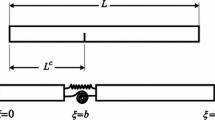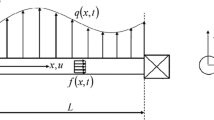Abstract
In this paper, the coupled bending and torsional vibration analysis of microbeams under axial force based on Timoshenko’s beam theory is investigated. Modified non-classic coupled stress theory and the Hamilton principle used to establish the motion equations of the system. The generalized differential quadratures method is used to solve the obtained set of differential equations. After establishment of eigenvalue problem, two comparison studies are conducted to assure the validity and accuracy of the present solution and excellent agreement observed with the present results and those reported by other researchers in some specific cases by analytical solutions and classical beam theory. Afterwards, parametric studies are developed to examine the influences of boundary conditions, size effect, and various geometric characteristics of the beam on natural frequencies and the associated mode shapes are discussed. The results show that the non-compliance of the mass axis with the elastic axis reduces the natural frequency. Also, Poisson’s ratio have an opposite effect on the natural frequency.








Similar content being viewed by others
References
Takawa T, Fukuda T, Takada T. Flexural-torsion coupling vibration control of fiber composite cantilevered beam by using piezoceramic actuators. Smart Mater Struct. 1997;6(4):477.
Eslimy-Isfahany SHR, Banerjee JR. Use of generalized mass in the interpretation of dynamic response of bending–torsion coupled beams. J Sound Vib. 2000;238(2):295–308.
Banerjee JR. Coupled bending–torsional dynamic stiffness matrix for beam elements. Int J Numer Meth Eng. 1989;28(6):1283–98.
Banerjee JR, Williams FW. Coupled bending-torsional dynamic stiffness matrix of an axially loaded Timoshenko beam element. Int J Solids Struct. 1994;31(6):749–62.
Banerjee JR, Fisher SA. Coupled bending–torsional dynamic stiffness matrix for axially loaded beam elements. Int J Numer Methods Eng. 1992;33(4):739–51.
Eslimy-Isfahany SHR, Banerjee JR, Sobey AJ. Response of a bending–torsion coupled beam to deterministic and random loads. J Sound Vib. 1996;195(2):267–83.
Kaya MO, Ozgumus OO. Flexural–torsional-coupled vibration analysis of axially loaded closed-section composite Timoshenko beam by using DTM. J Sound Vib. 2007;306(3–5):495–506.
Lee U, Jang I. Spectral element model for axially loaded bending–shear–torsion coupled composite Timoshenko beams. Compos Struct. 2010;92(12):2860–70.
Daneshmehr AR, Nateghi A, Inman DJ. Free vibration analysis of cracked composite beams subjected to coupled bending–torsion loads based on a first order shear deformation theory. Appl Math Model. 2013;37(24):10074–91.
Sari MES, Al-Kouz WG, Al-Waked R. Bending–torsional-coupled vibrations and buckling characteristics of single and double composite Timoshenko beams. Adv Mech Eng. 2019;11(3):1687814019834452.
Soltani M, Atoufi F, Mohri F, Dimitri R, Tornabene F. Nonlocal analysis of the flexural–torsional stability for FG tapered thin-walled beam-columns. Nanomaterials. 2021;11(8):1936.
Li L, Hu Y. Nonlinear bending and free vibration analyses of nonlocal strain gradient beams made of functionally graded material. Int J Eng Sci. 2016;107:77–97.
Lei J, He Y, Zhang B, Gan Z, Zeng P. Bending and vibration of functionally graded sinusoidal microbeams based on the strain gradient elasticity theory. Int J Eng Sci. 2013;72:36–52.
Habibi B, Beni YT, Mehralian F. Free vibration of magneto-electro-elastic nanobeams based on modified couple stress theory in thermal environment. Mech Adv Mater Struct. 2019;26(7):601–13.
Alibeigi B, Beni YT, Mehralian F. On the thermal buckling of magneto-electro-elastic piezoelectric nanobeams. Eur Phys J Plus. 2018;133(3):1–18.
Mohtashami M, Beni YT. Size-dependent buckling and vibrations of piezoelectric nanobeam with finite element method. Iran J Sci Technol Trans Civ Eng. 2019;43(3):563–76.
Tadi Beni Z, Hosseini Ravandi SA, Tadi Beni Y. Size-dependent nonlinear forced vibration analysis of viscoelastic/piezoelectric nano-beam. J Appl Comput Mech. 2020;7(4):1878-91.
Civalek Ö, Dastjerdi S, Akbaş ŞD, Akgöz B. Vibration analysis of carbon nanotube-reinforced composite microbeams. Math Methods Appl Sci. 2021. https://doi.org/10.1002/mma.7069.
Uzun B, Kafkas U, Yaylı MÖ. Free vibration analysis of nanotube based sensors including rotary inertia based on the Rayleigh beam and modified couple stress theories. Microsyst Technol. 2021;27(5):1913–23.
Akbarzadeh Khorshidi M. Postbuckling of viscoelastic micro/nanobeams embedded in visco-Pasternak foundations based on the modified couple stress theory. Mech Time Depend Mater. 2021;25(2):265–78.
Alizadeh Hamidi B, Khosravi F, Hosseini SA, Hassannejad R. Free torsional vibration of triangle microwire based on modified couple stress theory. J Strain Anal Eng Des. 2020;55(7–8):237–45.
Banerjee JR. Free vibration of micro-beams and frameworks using the dynamic stiffness method and modified couple stress theory. In: Modern Trends in Structural and Solid Mechanics 2: Vibrations; 2021. p. 79–107. https://doi.org/10.1002/9781119831860.ch4.
Zanoosi AAP. Size-dependent thermo-mechanical free vibration analysis of functionally graded porous microbeams based on modified strain gradient theory. J Braz Soc Mech Sci Eng. 2020;42(5):1–18.
Mohammad-Abadi M, Daneshmehr AR. Size dependent buckling analysis of microbeams based on modified couple stress theory with high order theories and general boundary conditions. Int J Eng Sci. 2014;74:1–14.
Jalali MH, Zargar O, Baghani M. Size-dependent vibration analysis of FG microbeams in thermal environment based on modified couple stress theory. Iran J Sci Technol Trans Mech Eng. 2019;43(1):761–71.
Ma HM, Gao XL, Reddy J. A microstructure-dependent Timoshenko beam model based on a modified couple stress theory. J Mech Phys Solids. 2008;56(12):3379–91.
Ghafarian M, Ariaei A. Forced vibration analysis of a Timoshenko beam featuring bending-torsion on Pasternak foundation. Appl Math Model. 2019;66:472–85.
Fu Y, Zhang J. Modeling and analysis of microtubules based on a modified couple stress theory. Physica E. 2010;42(5):1741–5.
Tadi Beni Y, Karimi Zeverdejani M. Free vibration of microtubules as elastic shell model based on midified couple stress theory. J Mech Med Biol. 2015;15(03):1550037.
Ebrahimi N, Beni YT. Electro-mechanical vibration of nanoshells using consistent size-dependent piezoelectric theory. Steel Compos Struct. 2016;22(6):1301–36.
Zeighampour H, Tadi Beni Y. Cylindrical thin-shell model based on modified strain gradient theory. Int J Eng Sci. 2014;78:27–47.
Mehralian F, Tadi Beni Y. Vibration analysis of size-dependent bimorph functionally graded piezoelectric cylindrical shell based on nonlocal strain gradient theory. J Braz Soc Mech Sci Eng. 2018;40:27.
Yang FACM, Chong ACM, Lam DCC, Tong P. Couple stress based strain gradient theory for elasticity. Int J Solids Struct. 2002;39(10):2731–43.
Ng CHW, Zhao YB, Xiang Y, Wei GW. On the accuracy and stability of a variety of differential quadrature formulations for the vibration analysis of beams. Int J Eng Appl Sci. 2009;1(4):1–25.
Tornabene F, Fantuzzi N, Bacciocchi M. Strong and weak formulations based on differential and integral quadrature methods for the free vibration analysis of composite plates and shells: convergence and accuracy. Eng Anal Bound Elem. 2018;92:3–37.
Fantuzzi N, Tornabene F, Bacciocchi M, Neves AM, Ferreira AJ. Stability and accuracy of three Fourier expansion-based strong form finite elements for the free vibration analysis of laminated composite plates. Int J Numer Methods Eng. 2017;111(4):354–82.
Tornabene F, Fantuzzi N, Ubertini F, Viola E. Strong formulation finite element method based on differential quadrature: a survey. Appl Mech Rev. 2015;67(2):020801.
Li J, Shen R, Hua H, Jin X. Coupled bending and torsional vibration of axially loaded thin-walled Timoshenko beams. Int J Mech Sci. 2004;46(2):299–320.
Ke LL, Wang YS, Yang J, Kitipornchai S. Nonlinear free vibration of size-dependent functionally graded microbeams. Int J Eng Sci. 2012;50(1):256–67.
Author information
Authors and Affiliations
Corresponding author
Additional information
Publisher's Note
Springer Nature remains neutral with regard to jurisdictional claims in published maps and institutional affiliations.
Appendices
Appendix A
Appendix B
The bending–torsion coupled governing motion equations of axially loaded Timoshenko microbeam after applying the GDQ method may be written in the following form
Rights and permissions
About this article
Cite this article
Balali Dehkordi, H.R., Tadi Beni, Y. Size-dependent coupled bending–torsional vibration of Timoshenko microbeams. Archiv.Civ.Mech.Eng 22, 124 (2022). https://doi.org/10.1007/s43452-022-00435-3
Received:
Revised:
Accepted:
Published:
DOI: https://doi.org/10.1007/s43452-022-00435-3




